
Grad student accidently discovered an exception to laws of thermodynamics
University of Massachusetts Amherst researchers discover 'shape-recovering liquid' defying thermodynamics. The discovery doesn’t have any practical applications right now, but so what? It’s still cool.
Comment
0

This £14 billion airport in Asia is sinking fast into the sea
Kansai International Airport in Osaka, Japan, which serves over 30 million passengers annually, is reportedly sinking into the sea due to rising sea levels and land subsidence.
Read More
Comment
0

130 countries now negotiating trade deals with the US, NEC Director Kevin Hassett says
"Right now, 130 countries- 130 countries- have responded and we're negotiating with them."
Read More
Comment
0

It’s official: Man Utd have lost more league games since 2013 than in Fergie’s 21 years
115 vs 114: Man Utd losses since Ferguson now exceed his PL tenure
Read More
Comment
0

STATEHOUSE PRESS STATEMENT: Presidency disclaims 2027 campaign billboards nationwide
The Presidency has expressed concern over the unauthorized appearance of billboards in cities like Abuja and Kano promoting President Bola Tinubu and Vice President Kashim Shettima for the 2027 elections
Read More
Comment
0

Charles Bassey, former Green Eagles star and teammate of Christian Chukwu, dies at 71
Former Green Eagles midfielder Charles Bassey, 71, has died, the NFF confirmed, calling him “a committed servant of Nigerian football.”
Read More
Comment
0

Presidency responds to US Court order on Tinubu’s FBI, DEA records
Nothing new to reveal, says Bayo Onanuga, President's Senior Aide
Read More
Comment
0

Presidency reacts to U.S. court order on Tinubu records, says reports long public and non-indicting
The Presidency says U.S. records on Tinubu are decades old and contain no indictments.
Read More
Comment
0

Trump makes Holy Week proclamation acknowledging Jesus Christ as ‘the living Son of God’
Trump champions Jesus' 'miraculous Resurrection' in Palm Sunday message vowing to 'defend the Christian faith'
Read More
Comment
0

U.S. Embassy to implement tougher visa rules for Nigerians from April 22
From April 22, the U.S. will require Nigerians to present more detailed documents and face stricter interviews when applying for visas.
Read More
Comment
0